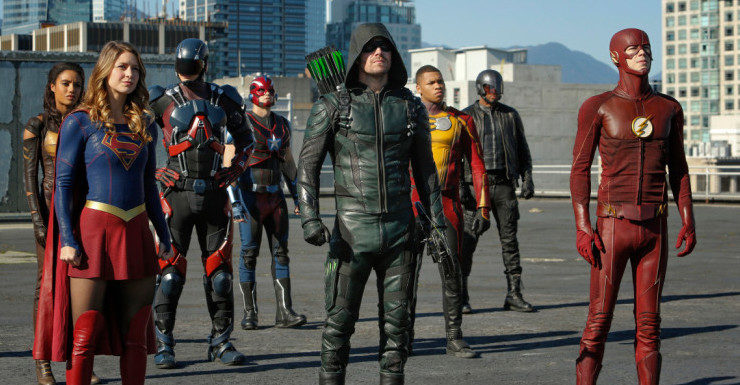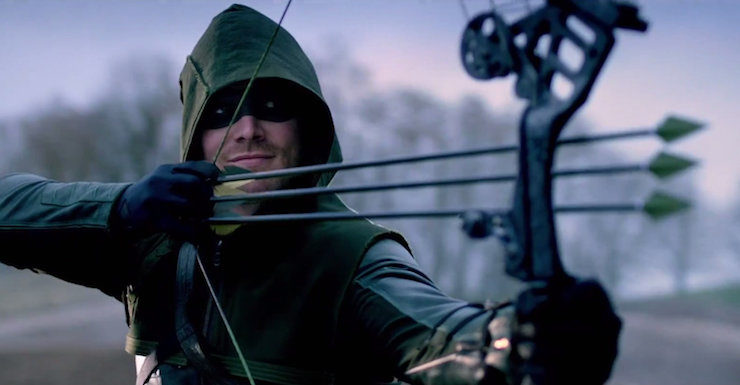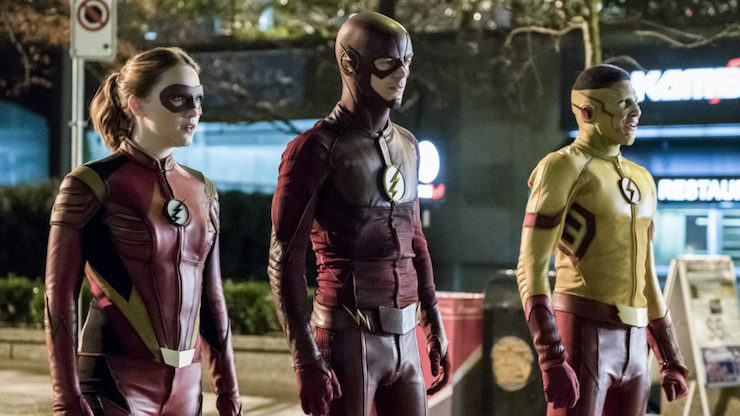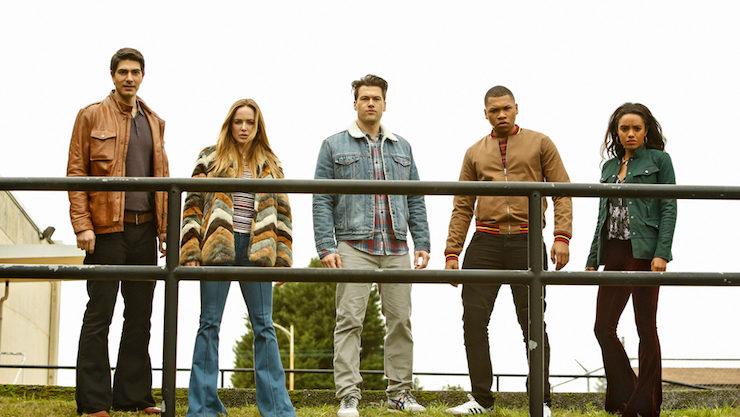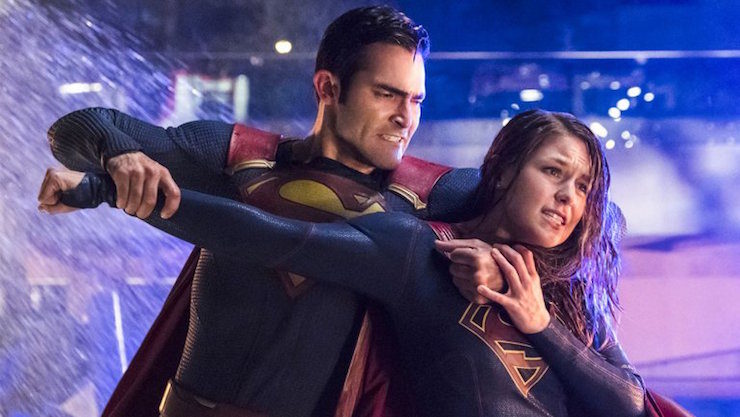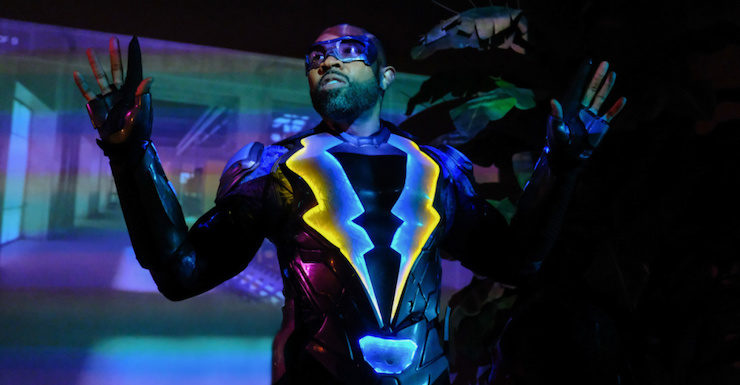We’re in the home stretch for this season’s run of DC live action TV shows right now. Legends of Tomorrow recently wrapped up with a magnificent, over-caffeinated hour of maniacal invention while Black Lightning’s finale brought everything full circle back to the Pierce family and their future. Elsewhere, Supergirl is starting in on the back end of the season, The Flash has two episodes to go and has rarely been better than it is right now, and Arrow is finally course-correcting after a dismally uneven year.
So: Five core TV shows, not counting the various animated spinoffs, all from the same production house and all dealing with DC characters. Each one is successful, each one is popular, and each one, when laid out in chronological order of release shows us something fascinating. It shows us that, despite the endless, interminable claims that superhero TV is all the same, in reality, it’s a medium that is evolving at an increasingly rapid rate.
Let’s start with Arrow. Captain Grumpypants has been the DC live action stand-in for Batman (and to a lesser extent, Tony Stark) for years now. Justin Hartley’s version of the character on Smallville did the job well, and Stephen Amell, who’s basically a work ethic given human form, has been consistently amazing in the role on Arrow.
And, honestly, he’s needed to be. Arrow is the oldest of these shows and the approach it takes embodies the original model—the one that’s been used ever since Smallville got word that Gotham’s grumpiest son was off-limits. Oliver is functionally Batman: a billionaire loner with a heart of gold, fists of steel, and total emotional incompetence. Team Arrow maps pretty solidly onto the structure of the Bat-family in the comics, too, and the issues the show has had and continues to have are rooted in the team and how they’re dealt with. Season 6, aside from a staggeringly ill-advised and badly executed Civil War cover version, has focused on Oliver’s attitude towards his team and on the team’s towards him. He doesn’t play well with others. Others have noticed. The end result is, at time of writing, the vastly inflated cast of the show is in the process of being whittled down to just Oliver in the field: A lone vigilante, stalking the night and protecting a city that hates and fears him. It’s amazing he doesn’t have an Arrow signal.
So, stage one of TV Superhero Evolution is, basically: Be Batman (or at least as Batmanesque as possible). Which is understandable because of how enduring a character he is, but often not that interesting, also because of how enduring a character he is. Don’t get me wrong—Arrow’s still fun and, at times, a great show, but in Season 6 more than ever the show is really starting to chafe against the Wayne-ian framework it finds itself within. The, fairly colossal rumoured reboot for Season 7 involves a possible do-over/stealth adaptation of the abandoned Green Arrow movie, Escape from Super Max, which would open with Oliver in prison—and honestly, I’d be all for that approach. It’s a show that needs to break the mold every couple of years and that latest break seems a bit overdue, at this stage in the series.
Especially since every show that’s followed it on the network has engaged in exactly that sort of mold-breaking, with solid results.
Season 4 of The Flash is the best the show has ever been precisely because of how much change they’ve embraced. When the show began, Barry was a lone superhero with a small technical support team hiding his identity from his family. As Season 4 sprints to a close, Barry is the head of a team of ad hoc superheroes that also includes his father-in-law and wife as support and command staff. It’s more Awesome Science Friends than Justice League S.T.A.R. Labs, but it’s worked brilliantly for a while now.
While Oliver has been loaded down with Bruce Wayne-ian grimness and isolation, Barry is an amiable science puppy who loves people. Better still, he’s been allowed to grow from that characterization, and Season 4’s repositioning of Barry and Iris (who was horrendously written in the show’s early seasons), as the series’ designated adults pays off every single episode. If Oliver is the reluctant head of a team, then Barry and Iris are the deliberate, capable parents of a fractious, eccentric family. Each has grown into their roles, the show has grown to encompass new characters and ideas, and it’s paid off time and again. The simple fact that Season 4’s villain is not an evil speedster speaks to that development, as does its willingness—as evidenced by the surprise team death in recent episode “Lose Yourself”—to make the hard, unexpected choices.
And that brings us to the Legends. There’s absolutely no reason why Legends of Tomorrow should work. None at all. It’s a grab bag cast of characters, some from the other shows, most not, careening around time and space, breaking things, fixing more things, and basically making it all up as they go. It’s Drunk Doctor Who. It’s community theatre Quantum Leap.
It’s also one of my all-time favorite TV shows.
Not just because I will always be there for Mystery Men-style misfit superheroes (Excuse me while I decide whether or not to eat this egg sandwich), but because Legends feels completely different when compared to its network stablemates. Arrow is noirish, with a ninja lurking in every alleyway and an evil CEO in every boardroom. The Flash is Silver Age Science nonsense complete with Sonic Scepters, Samuroids, and magnificently terrible science.
Legends of Tomorrow is…well, they’re the other guys. None of the angst of Oliver. None of the exuberance of Barry. Just a group of suspiciously normal-seeming extraordinary people who are making their peace with their flaws. Season 3 really brought this to the fore, too, balancing everything from trans-temporal grief counseling to a climactic fight which landed halfway between Voltron and End of Days. All of this is ridiculous, the show knows it—and that’s Legends’ first secret.
The second is that these characters are the most emotionally honest in the entire CWverse. Recent episode “Here I Go,” which I’ll soon be writing about in depth elsewhere, embodies this. A traditional “ship blows up, everyone dies, repeat” story, it could easily have been dialed in. Instead, over the course of the episode we saw one character admit why she’s emotionally terrified to enter a new romantic relationship, another pair use a memory eraser to have endless breakup sex, and the reveal that the last person you’d expect is actually a kind of amazing author. Better still? The show features characters who know exactly what TV show they’re starring in. Witness Nate and Ray just needing to hear the words “time loop” to figure out what to do. In the hands of lesser writers, beats like this—or the casting of John Noble in a cameo as himself…in the same show in which he voices a villain—would read as smug. Instead, it combines the exuberance of The Flash with a postmodern willingness to engage with EVERYTHING to create a show that’s by turns the saddest, funniest, and most hopeful of all of them.
So, if Arrow is noir, The Flash is Silver Age superhero science fiction, and Legends is the scrappy, self-aware postmodern younger sibling, what’s Supergirl?
Supergirl is vital. In both senses of the word.
Supergirl represents the hard left turn the CWverse needed to make into exploring new and different perspectives. Stepping up from the ensemble approach of Legends, it takes a look at the DC universe through the eyes of a woman—and, arguably, one of the DCEU’s two most iconic female characters.
That means the show bakes in an unusual perspective from the get-go. Kara Danvers is the cousin of Superman. She’s always going to be compared to him, and the show does a great job of exploring how she and Clark both struggle with that relationship. Better still, it maps the challenge of being who you’re expected to be and who you are onto the duality of Kara Danvers and Supergirl, with star Melissa Benoist doing a consistently excellent job of playing the two with vastly different physical presences.
She also gives the character more emotional nuance and subtlety than every previous version. An early episode explores Kara’s survivor’s guilt, and how that ties into the anger she understandably feels and has been taught to conceal. More recently, the show has dealt with how we heal following emotional trauma—or rather, how we more often hide inside destructive behaviour before we can begin to heal. It’s nuanced, complicated, and emotionally honest work that has, when combined with the show’s willingness to get its knuckles bloody, made this take on the character feel definitive. While tonally still very much in keeping with the other CW shows, Supergirl is also thematically different, and deeper, than they are.
And finally, we have Black Lightning, which just wrapped a bravura first season. This is, for now, the one show that doesn’t explicitly tie into the others. That being said, Black Lightning averaged one DC reference an episode for the back half of its season, and an eventual five-way crossover seems so certain that Stephen Amell is openly talking about when it’ll happen.
When it does, it’s going to play very differently from previous versions of crossover events. Black Lightning is far and away the most unique CW superhero show to date, on three different levels. Firstly, airing in the UK on Netflix as it does, it rewards binge-watching. The season seems to have been built in a similar manner to a lot of Netflix shows, from what I can tell: frontloading in the first six, constant payoffs in the back half. The show’s narrative is almost novelistic in a way that none of the others come close to.
It also has a distinct setting—a larger sense of community and place—that’s inextricable from the show’s purpose and identity in a way that none of the other shows do. Jefferson Pierce and his family are concerned with the safety and well-being of Freeland, from the streets on up through the rest of the community. This isn’t the oddly-deserted recent apocalypse of Star City, or Central City where we only really ever see innocent bystanders when someone needs to be shown being imperiled. Over the course of the first season of Black Lightning we’ve met the kids Jefferson teaches, his coworkers, his old friends, his children’s friends and classmates, and more. Freeland feels small, in a way that also feels realistic. This is a city where the chances of you working with someone you went to school with are pretty high. The chances of not everyone you know making it to adulthood are pretty high, too.
That close focus pays dividends for the show’s most important element: its continuing conversation about it means to be a black man in modern America and the way that social change can become a catalyst for both conflict and hope. The season has never, once, backed down from a fight. An early episode sees Jefferson as the victim of a random crime stop. A later episode features a deeply uncomfortable, deeply necessary, sequence of him being processed into the system after being arrested. The decisions he constantly faces—how to channel his anger, how to set an example—are the same struggles that Oliver Queen has spent six seasons shadowboxing with. The difference is that here there’s a very deliberate and consequential streak of realism to every choice.
That realism extends to the exploration of Jefferson and Lynn’s marriage, the way their daughters struggle to get out from under their dad’s shadow, and even the weaponised gentrification practiced by the A.S.A. It’s a show where character and city alike are a battleground, and one that is constantly revealed to us through multiple viewpoints: the members of the Pierce family, Gambi, the vox pops scattered through the show. All of it makes Freeland seem like a real and grounded place in a way that no other DCEU city is. All of it promises much and delivers more. All of it makes Black Lightning the most essential show in the television DCEU.
“The Berlantiverse,” “the Arrowverse,”—call it what you will. But these TV shows are providing the trailhead and creating the map for how live action superhero series drama has and will continue to evolve. Every approach here is valid, whether it’s the Batman-esque drama of Arrow or the nuanced social dynamics of Black Lightning. All of them are doing something different, all of them proving the worth of the medium when it comes to bringing these outsized narratives to life, and all of them show just how important, diverse, and vital superhero fiction can and should be. That five-way crossover, when it happens, is going to be FUN.
Alasdair Stuart is a freelancer writer, RPG writer and podcaster. He owns Escape Artists, who publish the short fiction podcasts Escape Pod, Pseudopod, Podcastle, Cast of Wonders, and the magazine Mothership Zeta. He blogs enthusiastically about pop culture, cooking and exercise at Alasdairstuart.com, and tweets @AlasdairStuart.










